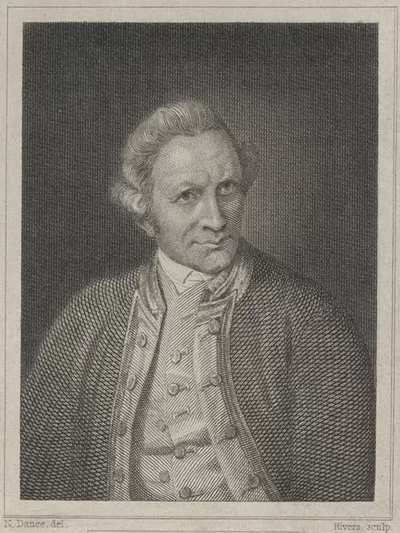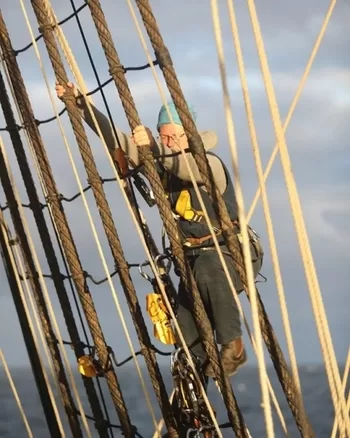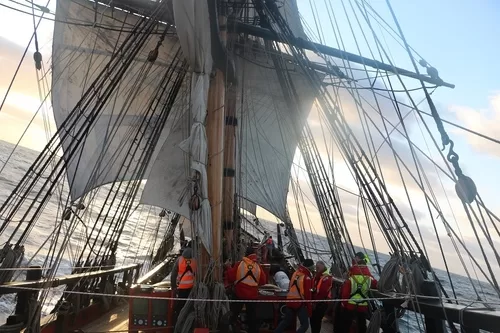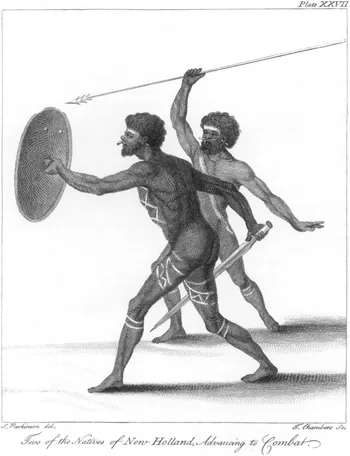CAPTAIN COOK’S life, or the account of so much of it as is recoverable, has been so often recounted that there is no occasion to insert more in this publication than is necessary as a reference to the reader, to enable him to realise the career and character of the man.
By CAPTAIN W.J.L. WHARTON, R.N., F.R.S. Hydrographer of the Admiralty, 1893
Cook’s first biographer, Andrew Kippis, wrote in 1788, and his work has recently been republished.* (* “A Narrative of the Voyage round the World, performed by Captain James Cook, with an Account of His Life” by A. Kippis, D.D., F.R.S. London: Bickers & Son 1889.)
The latest and best life is by Walter Besant,* (* “Captain Cook” by Walter Besant: “English Men of Action” London, Macmillan & Co. 1890.) whose graceful pen has given us a fascinating, interesting, and, as far as is possible, complete picture of this great Englishman.
Many details of Cook’s private life are lost, but enough has been collected by Mr. Besant to place our hero vividly before us, and a perusal of his work is strongly recommended.
Many things in the following sketch are taken from Mr. Besant, to whom I wish to tender my acknowledgments.
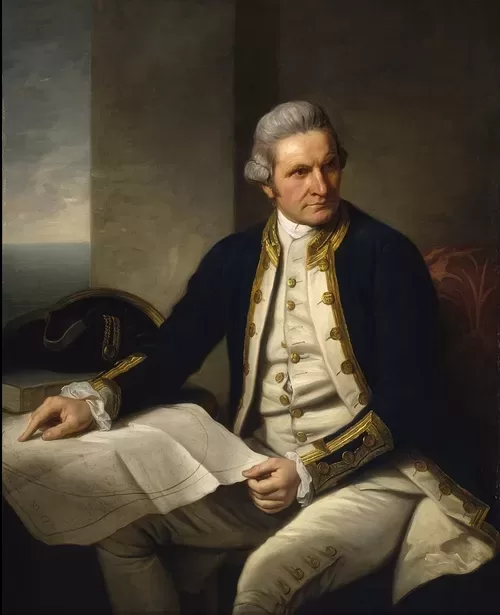

Official portrait of Captain James Cook
Nathaniel Dance-Holland, from the National Maritime Museum, United Kingdom
1 January 1775
James Cook rose from nearly the lowest ranks.
The second son of James Cook, a Yorkshire labourer, and Grace his wife, he was born on the edge of the Cleveland Hills on February 27th, 1728, in the little village of Marton, which lies about four miles south-south-east of Middlesborough, and five miles west of the well-known hill and landmark, Roseberry Topping.
Eight years later his father removed to Great Ayton, which lies close under Roseberry Topping.
At the age of thirteen Cook, who, it is recorded, had had some elementary schooling both at Marton and Great Ayton, was apprenticed to one Sanderson, a draper and grocer of Staithes, a fishing village on the coast, about fourteen miles from Ayton and nine north-west of Whitby.
A year later Cook went, or ran away, to sea, shipping at Whitby on board the Freelove, a collier belonging to the brothers Walker.
In this hard school Cook learnt his sailor duties.
No better training could have been found for his future responsibilities.
Here he learnt to endure the utmost rigours of the sea. Constant fighting with North Sea gales, bad food, and cramped accommodation, taught him to regard with the indifference that afterwards distinguished him, all the hardships that he had to encounter, and led him to endure and persevere where others, less determined or more easily daunted by difficulties, would have hurried on, and left their work incomplete.
All details of Cook’s life during his thirteen years in the merchant service are lost: what voyages he made, how he fared, whether he advanced in general knowledge, all is gone.
The only fact known is that in May 1755, when Cook was twenty-seven years of age, and mate of a vessel of Messrs. Walker, then in the Thames, he, to avoid the press, then active on account of the outbreak of the war with France, volunteered on board H.M.S. Eagle, of 60 guns, as an able seaman.
Captain Hugh Palliser, who succeeded to the command of this ship in October, was certainly Cook’s warmest patron, and it would appear that Cook did work superior to that of an able seaman in the Eagle.
Be that as it may, all that is absolutely known is that that ship took her share of the fighting at the taking of Louisbourg and elsewhere on the North American and West Indian Station, and returned to England in 1759.
By Palliser’s interest Cook was now appointed master of the Mercury. It is therefore evident that his qualifications as a navigator recommended themselves to Palliser.
The Mercury went to North America, and here Cook did his first good service recorded, namely, taking soundings in the St. Lawrence, to enable the fleet then attacking Quebec to take up safe positions in covering the army under Wolfe.
This he accomplished with great skill, under many difficulties, in the face of the enemy, much of it being done at night.
He was immediately employed in making a survey of the intricate channels of the river below Quebec, and for many years his chart was the guide for navigation.
Cook was indeed a born surveyor. Before his day charts were of the crudest description, and he must have somehow acquired a considerable knowledge of trigonometry, and possessed an intuitive faculty for practically applying it, to enable him to originate, as it may truly be said he did, the art of modern marine surveying.
The expedition to Quebec concluded, Cook was appointed master of the Northumberland, bearing Admiral Lord Colville’s flag, and during that ship’s winter at Halifax he applied himself to further study of mathematics and astronomy.
In 1762, the Northumberland being at Newfoundland during the capture of that island from the French, Cook again was employed in surveys.
This attracted the attention of Captain Graves, the Governor, who conceived a high opinion of his abilities in this respect.
In the latter part of 1762 Cook returned to England and married Elizabeth Batts, daughter of a man in business at Wapping; but a few months afterwards he was called upon by Captain Graves to go again to Newfoundland to make marine surveys.
In this important work he was engaged until 1767, Captain Palliser, who succeeded Captain Graves as Governor, being only too glad to avail himself of Cook’s services.
The charts he made during these years in the schooner Grenville were admirable.
The best proof of their excellence is that they are not yet wholly superseded by the more detailed surveys of modern times.
Like all first surveys of a practically unknown shore, and especially when that shore abounds in rocks and shoals, and is much indented with bays and creeks, they are imperfect, in the sense of having many omissions; but when the amount of the ground covered, and the impediments of fogs and bad weather on that coast is considered, and that Cook had at the most only one assistant, their accuracy is truly astonishing.
The originals of these surveys form part of the most precious possessions of the Hydrographic Office of the Admiralty.
We now approach the crowning achievements of Cook’s life.
After many years’ neglect the exploration of the Pacific was awaking interest.
This great ocean, which very few, even to this day, realise occupies nearly one half of the surface of the globe, had been, since the first voyage of Magellan, crossed by many a vessel.
Notwithstanding, very little was known of the islands occupying its central portion.
For this there were two reasons.
First, the comparatively small area covered by islands; secondly, the fact that nearly all who traversed it had followed Magellan’s track, or, if they started, as many did, from Central America, they made straight for Magellan’s discovery, the Ladrone Islands. For this, again, there was a reason.
Few sailed for the purpose of exploration pure and simple; and even those who started with that view found, when embarked on that vast expanse, that prudence dictated that they should have a moderate certainty of, by a certain time, falling in with a place of sure refreshment.
The provisions they carried were bad at starting, and by the time they had fought their way through the Straits of Magellan were already worse; water was limited, and would not hold out more than a given number of days. Every voyage that is pursued tells the same story—short of water, and eagerly looking out for an opportunity of replenishing it.
The winds were found to blow in fixed directions, and each voyager was fearful of deviating from the track on which it was known they would be fair, for fear of delays.
And ever present in each captain’s mind was the dread of the terrible scourge, scurvy. Every expedition suffered from it. Each hoped they would be exempt, and each in turn was reduced to impotence from its effects.
It was the great consideration for every leader of a protracted expedition, How can I obviate this paralyzing influence? And one after another had to confess his failure.
It is yearly becoming more difficult for us to realise these obstacles.
The prevailing winds and currents in each part of the ocean are well known to us: the exact distance and bearing from one point to another are laid down in the chart; steam bridges over calm areas, and in many cases conducts us on our entire journey at a speed but little inferior to that of land travelling by railroad; modern science preserves fresh and palatable food for an indefinite period; and, in a word, all the difficulties and most of the dangers of long voyages have disappeared.
Take one element alone in long voyages—the time required. The average progress of a ship in the eighteenth century was not more than fifty miles a day.
Nowadays we may expect as much as four hundred miles in a full powered steamer, and not less than one hundred and fifty in a well-fitted sailing ship.
But navigation, and more especially the navigation of the unknown Pacific, was very different in Cook’s days, when all the obstacles above mentioned impeded the explorers, and impelled them to follow a common track.
There were a few who had deviated from the common track.
The Spaniards, Mendana, Quiros, Torres, in the latter part of the sixteenth century, starting first from their colonies in Peru, had ventured along the central line of the Pacific, discovering the Marquesas, certain small coral islands, the Northern New Hebrides, and the Solomon Islands; but their voyages, mainly for fear of Drake and his successors, were kept so secret that no one quite knew where these islands lay.
Abel Tasman, in 1642, coming across the Indian Ocean from the westward, had touched at Tasmania, or, as he called it, Van Diemen’s Land, had skirted the western coast of the north island of New Zealand without landing, and had stretched away to the north-east, and found the Tonga Group.
The English Buccaneers were not among these discoverers; Dampier, Woods Rogers, and others, all went from Acapulco to the Ladrones, looking out for the valuable Spanish galleons from Manila, and they added little or nothing to the knowledge of the Pacific and what it contained.
It was not therefore strange that the imagination of geographers ran riot amongst the great unknown areas.
They were impressed, as they looked at the globes of the day, with the fact that, while the northern hemisphere contained much land, the southern showed either water or blank spaces; and starting with the ill-founded idea that the solid land in either hemisphere should balance, they conceived that there must be a great unknown continent in the southern part of the Pacific to make up the deficiency.
This was generally designated Terra Australis Incognita, and many is the ancient chart that shows it, sketched with a free and uncontrolled hand, around the South Pole.
It was held by many that Tasman had touched it in New Zealand; that Quiros had seen it near his island of Encarnacion, and again at Espiritu Santo (New Hebrides), but no one had been to see.
In George III’s reign the desire to know more of this unknown ocean arose in England.
The king himself took great interest in it, and for the first time since Queen Elizabeth’s age, when Davis, Frobisher, Drake, Narborough, and others, had gone on voyages of discovery, the pursuit was renewed.
In 1764 the Dolphin and Tamor, under the command of Commodore Byron and Captain Mouat, sailed on a voyage round the world. They spent some time, as ordered, in exploring the Falkland Islands, and, after a two months’ passage through Magellan Strait, they stood across the Pacific.
They, however, also followed near the well-beaten track, and passing north of the Paumotus, of which they sighted a few small islands, they too made for the Ladrones.
As usual, they suffered much from scurvy, and the one idea was to get to a known place to recover.
Byron returned in May 1766, having added but little to the knowledge of the Pacific, and the Dolphin was again sent in the August of the same year, with the Swallow, under the command of Captains Wallis and Carteret, on a similar voyage.
They did somewhat better. After the usual struggle through the long and narrow Strait of Magellan, against the strong and contrary winds that continually blow, and which occupied four months, they got into the Pacific.
As they passed out they separated, the Dolphin outsailing the Swallow, and a dispassionate reader cannot well escape the conclusion that the senior officers unnecessarily parted company.
The Dolphin kept a little south of the usual route, fell in with some of the Paumotu Group, and finally discovered Tahiti, where she anchored at Royal Bay, after grounding on a reef at its entrance, with her people, as usual, decimated by scurvy.
They were almost immediately attacked by the natives, who, however, received such a reception that they speedily made friends, and fast friends too.
The remainder of the month of the Dolphin stay was marked with the most friendly intercourse, and she sailed with a high opinion of Tahiti and the Tahitians; the Queen, Cook’s Obereia, being especially well disposed to them.
Their communication with the natives must, however, have been limited, as they remained too short a time to learn the language, and we gather little of the manners and customs from the account of the voyage.
After sailing from Tahiti we hear the same tale—sickness, want of water, doubt of what was before them. After sailing by several small islands, and an attempt to water at one, course was steered as before for the Ladrones.
Let Wallis tell his own story. He says:—
“I considered that watering here would be tedious and attended with great fatigue; that it was now the depth of winter in the southern hemisphere; that the ship was leaky, that the rudder shook in the stern very much, and that what other damage she might have received in her bottom could not be known.
That for these reasons she was very unfit for the bad weather which she would certainly meet with, either in going round Cape Horn or through the Streight of Magellan; that if she should get safely through the streight or round the Cape, it would be absolutely necessary to refresh in some port; but in that case no port would be in her reach.
I therefore determined to make the best of my way to Tinian, Batavia, and so to Europe by the Cape of Good Hope.
“By this rout, as far as we could judge, we should sooner be at home; and if the ship should prove not to be in a condition to make the whole voyage, we should still save our lives, as from this place to Batavia we should probably have a calm sea, and be not far from a port.”
Captain Wallis
These are scarcely the sentiments of a bold explorer, and we shall look in vain for any similar ideas on the part of Cook.
Here was a ship just a year from England, just come from a convenient and friendly island, where every refreshment and opportunity for refit were to be found, and the only thought is how to get home again!
It was the vastly different conduct of Cook’s voyages; the determination that nothing should stop the main object of the expedition; his resource in every difficulty and danger; that caused, and rightly caused, him to be hailed as a born leader of such expeditions.
Wallis followed nearly on Byron’s track: went from the Ladrones, through the China Sea, to Batavia, and so home, arriving in May 1768.
The Swallow, under Captain Carteret, was navigated in a different spirit. She was badly fitted out for such a voyage, had not even a forge, and all the articles for trade were on board the Dolphin.
But Carteret was not easily daunted. He might, under the circumstances, when he found himself alone, have abandoned the voyage; but he boldly went forward.
Passing from the Strait of Magellan, he touched at Juan Fernandez, and steering somewhat south of Wallis’s line, he passed south of Tahiti, discovering Pitcairn’s Island on his way, and some of the islands south of the Paumotus.
By this time his people were severely afflicted with scurvy, and his ship in a bad state; but Carteret only thought of getting to some place of refreshment, from which he might afterwards pass on his voyage towards the south, in the hope of falling in with the great southern Continent.
In this he was not fortunate. Missing all other islands, he fell across the Santa Cruz Group, and hoping that he had found what he wanted, he anchored and tried to water.
The party were, however, attacked by the natives, and several, including the master, were wounded and died by poisoned arrows.
All hope of a quiet refit was over, and his ship’s company being in a wretched condition, no forge or tools on board to enable him to effect his many repairs, Carteret, who was himself very ill, was obliged to give up all intention of exploration to the southward.
He got enough water to last him, and sailed on toward the Solomon Islands.
These he also just missed, but fell in with New Britain, and passing between it and New Ireland, demonstrated for the first time that these two large islands were not one, as had been supposed.
He here managed to do something to repair his leaky vessel, heeling and caulking her, but got little but fruit for his scurvy-stricken crew.
He was attacked by the fierce islanders, and was altogether unable to do as much as he evidently earnestly desired towards examining the islands.
Thence they struggled on by Mindanao to Makassar in Celebes, delayed by contrary winds, disappointed of refreshments at every place they tried, and losing men from scurvy.
At Makassar they met with but an inhospitable reception from the Dutch, who refused to permit them to receive refreshments there, and after waiting at Bonthain, a place in Celebes, several months, for the monsoon to change, they at last arrived at Batavia, the only port in the Dutch Indies really open to ships, in June 1768.
Thence, after heaving down and a thorough repair, they reached home, via the Cape, on March 20th, 1769.
Of all the voyages before Cook’s, Carteret’s showed most determination and true spirit of enterprise; and had his ship been better supplied, and more suited to the exigencies of such a long cruise, he would, but for one thing, have accomplished far more.
This was the fatal disease, which no captain had as yet succeeded in warding off, and which hampered and defeated the efforts of the most enthusiastic.
No man could go beyond a certain point in disregarding the health of his crew.
These, then, were the kind of voyages, with their scanty fruits, to which the English people were getting accustomed, and they were not such as to encourage repetition.
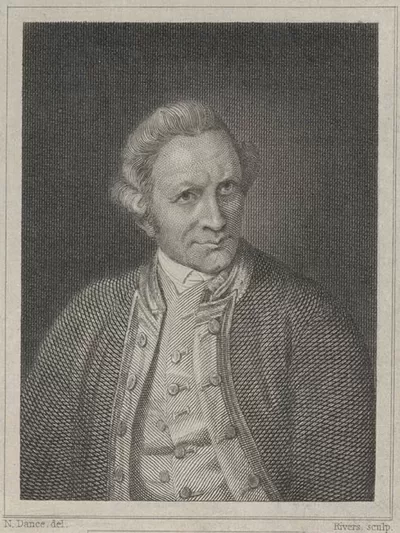

James Cook – N. Dance, del. Rivers. sculp.
State Library NSW
Captain James Cook personal life
Cook had six children. Three died young. Of the others, all boys, the eldest, James, entered the Navy, and lived to be a Commander, when, in 1794, he was drowned. The second, Nathaniel, also in the Navy, was lost in a hurricane in 1780. The third died when at Cambridge. They none of them lived to be married, and no descendant of the great navigator has perpetuated his race.
Of Cook’s private life during his brief intervals at home we know nothing. A man rising from the ranks, and of his reserved character, would have but few friends, when he had such short time to make them in his new sphere.
He lived at Mile End when at home, but after his death his widow removed to Clapham, living there for forty years, at first with her cousin, Isaac Smith, who had served with Cook in the Endeavour and Resolution. She died in 1835, at the great age of ninety-three.
Of Cook’s character, none could be a better judge than Captain King, who writes as follows, after describing his death:—
“Thus fell our great and excellent commander. After a life of so much distinguished and successful enterprise, his death, as far as regards himself, cannot be considered premature, since he lived to finish the great work for which he seems to have been designed.
How sincerely his loss was felt and lamented, by those who had so long found their general security in his skill and conduct, and every consolation in their hardships in his tenderness and humanity, it is neither necessary nor possible for me to describe.
The constitution of his body was robust, inured to labour, and capable of undergoing the severest hardships. His stomach bore without difficulty the coarsest and most ungrateful food. Indeed, temperance with him was scarcely a virtue, so great was the indifference with which he submitted to every kind of self-denial.
The qualities of his mind were of the same hardy, vigorous kind with those of his body. His understanding was strong and perspicacious. His judgment in whatever related to the service he was engaged in quick and sure.
His designs were bold and manly, and both in the conception and in the mode of execution bore evident marks of a great original genius. His courage was cool and determined, and accompanied by an admirable presence of mind in the moment of danger.
His manners were plain and unaffected. His temper might, perhaps, have been justly blamed as subject to haughtiness and passion, had not these been disarmed by a disposition the most benevolent and humane.
Those intervals of recreation, which sometimes unavoidably occurred, and were looked for by us with a longing that persons who have experienced the fatigues of service will readily excuse, were submitted to by him with a certain impatience whenever they could not be employed in making further provision for the more effectual prosecution of his designs.”
Captain King
This is a pretty complete picture, and of a great man; a man who had before him continually his duty, and who had in an eminent degree the capacity to carry it out.
Though, under his determination to do this, he drove his people hard; though he tried them with his irascibility; their conviction of his greatness, their confidence in his leadership and in his justice, led them to love him. He had no sympathy with the ordinary foibles and weaknesses of his men.
The charms of Tahiti, the paradise of the sailor, were no charms for him; he hardly notices the attractive ladies of that island; the attractions of the place to him were the abundance of provisions, as a means of fitting his expedition for further exploration and hardship.
The strongest proof of his capacity as a commander is the devotion of his officers. Those who know the Navy know how difficult it is for any man who rises from the ranks to be successful in command.
But Cook was a gentleman born; he had the intuition of great minds for fitting themselves to every position to which they may rise, and there is never a whisper of disinclination to submit to the rule of the once collier boy, the son of a labourer.
His intelligence is remarkably shown in his greatest triumph, the suppression of scurvy. That it should be left to a man of little education to discern the combination of means by which this enemy of long voyages could be conquered, is the most remarkable thing about this remarkable man.
He himself notices the disinclination of the sailor to any new article of food, especially when not particularly palatable; but he soon found the means to induce them to understand that their lives greatly depended upon these rather nasty messes.
Sour krout; the unsavoury portable soups of that day; the strange greens that Cook insisted on hunting up at every land he visited, and boiling with their ordinary food; the constant washing between decks; the drying below with stoves, even in the hottest weather; the personal baths; the change of wet clothing; the airing of bedding, were all foreign and repugnant to the notions of the seamen of the day, and it required constant supervision and wise management to enforce the adoption of these odd foods and customs.
It is evident that it is to Cook’s personal action the success was due. Wallis and Byron had anti-scorbutics, but they suffered from scurvy; Furneaux, sailing with Cook in the second voyage, under precisely similar circumstances, suffered from scurvy.
It was only in Cook’s ships, and in the Discovery, commanded and officered by men who had sailed with Cook, and seen his methods, that exemption occurred.
Cook did more, incomparably more, than any other navigator to discover new lands. This was only accomplished by dint of hard work; and yet his men suffered less than in any ships, British or foreign, or similar expeditions.
Though his tracks were in new and unknown waters, we never hear of starvation; he always manages to have an abundant supply of water.
The completeness and accuracy of his accounts and charts are no less remarkable.
M. de La Perouse, one of the foremost of the great French navigators, told Captain Phillip, the founder of the Colony of New South Wales, that “Cook had left him nothing but to admire.”
This was all but literally true; wherever Cook went he finished his work, according to the requirements of navigation of his time. He never sighted a land but he determined its dimensions, its shape, its position, and left true guides for his successors.
His charts are still for some parts unsuperseded, and his recorded observations still save us from hasty and incorrect alterations desired by modern navigators.
Well may Englishmen be proud that this greatest of navigators was their countryman.
Cook’s Journal from his First Voyage. In 1770, Lt. James Cook and the crew aboard H.M.B. Endeavour were the first British to make landfall on the east coast of what is now called Australia. Cook’s journal is illustrated by Mark Anning, photographer.
Captain James Cook personal life
Next: Persons who left England in H.M.B Endeavour, 26TH August, 1768

